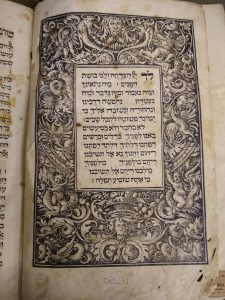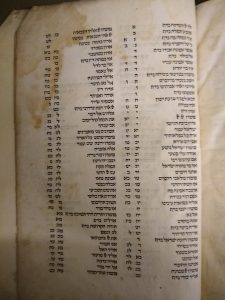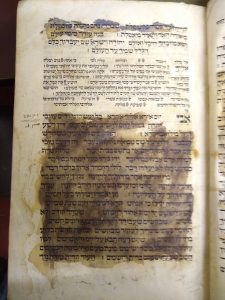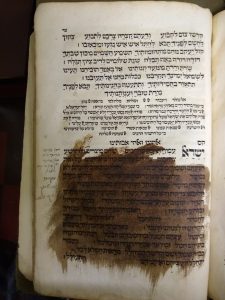
Many thanks to Lucia Raspe for sharing her work on censorship in early printed Selihot, which was very helpful in writing this post.
The Jewish month of Elul, coming right before the High Holidays of Rosh Hashana and Yom Kippur, is a particularly solemn one in Jewish religious life. Special penitential prayers, called Selihot, are recited in the days leading up to the High Holidays. The RBML holds a lovely copy of the Selihot according to the Ashkenazic rite*, printed in Augsberg in 1536, with a beautifully decorated opening page. One can see some staining on the book, likely tallow or wax from candles – Ashkenazi Selihot for this time of year begin on the Saturday night preceding Rosh Hashana (Sephardic communites begin Selihot at the beginning of Elul), and so the penitent would have needed candlelight to read the words in the text.

An index at the beginning (see photo, right) guides the user to the page pertaining to that particular day. Note that in addition to the days leading up to the High Holidays, Selihot are also recited on fast days throughout the year. Pagination, which premiered in the early 16th century for printed Hebrew books, guides the reader to the correct section for the particular day at hand. There are two columns of numbers (written as Hebrew letters): the first column is the page upon which the particular poem can be found; the second, a numerical designation for the poem (interestingly, not all of them were numbered). And so, as in the image below, poem #35 (לה) appears on page 22 (כב)

A closer look at the page above also shows that certain phrases were crossed out, and additional images show us that the censorship was in fact quite extensive! In some cases, it appears as if someone took (not a quill, but) a thick brush to eradicate particular sections of the prayers. Who did this, and why?



When dealing with expurgation in liturgical texts, it’s not always clear that cross-outs are the result of censorship; liturgy – and especially liturgy dealing with occasional prayers such as Selihot is fluid, and the fixed text of a printed volume may include prayers that are not recited by a particular community, as well as the reverse – it may leave out prayers that are recited by that community.

A private owner might thus cross out words or sections that aren’t relevant to prayers in his or her specific city or rite. A censor’s signature would confirm for us that this was the work of the church to remove allegedly anti-Christian material, but this particular book does not appear to have been signed by a censor. Scholarship (including the chapter cited below) indicates that there were six sets of selihot that would be removed from subsequent printings of this version of the prayers due to Christian censorship, and so it is possible that these were expurgated – possibly even by the Jewish owner – as a proactive measure to avoid controversy over the ownership and use of this book. Removing the passage didn’t mean a shortened prayer service, though! Handwritten notes in the margins next to each of the crossed-out passages indicate which prayers to say in lieu of each one being removed.

*Lucia Raspe’s “The Migration of German Jews into Italy and the Emergence of Local Rites of Selihot Recitation,” in The Jews of Europe around 1400; Disruption, Crisis, and Resilience (2018) 173-193 makes a compelling case that this was actually an Italo-Ashkenazi rite that perpetuated in print in both Northern Italy and Southern Germany well into the 16th century, possibly intended for sale in Italy. This hypothesis is furthered by an owner’s inscription in this particular volume: “I, Ya’akov ben Naftali ha-Kohen sold this Selihot to Ya’akov ben Shemu’el today, Sunday, 5 Elul 324 (1564)…of Gazzuolo.” Gazzuolo is a town near Mantua.
My thanks to Yisrael Dubitsky for some corrections, and also for pointing out that this was likely the printer in Mantua named Ya’akov ben Naftali of Gazzuolo- could he have held stock from the Augsburg press in his shop? There is always more to learn and more questions to ask!